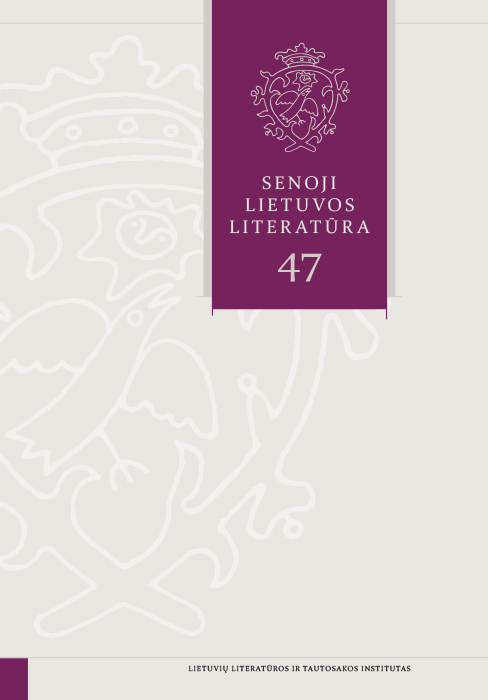Literary Activities of the Students and Professors of Kražiai College in the Seventeenth Century: Works Dedicated to the Elders of Samogitia
Abstract
The article continues the cycle on the literary activities of the students and professors of Kražiai College in the seventeenth century. The first article of the cycle addressed the state of research into the activities and history of Kražiai College, the problems related to the classification of extant works, and included the analysis of the works dedicated to the bishops of Samogitia. The present article deals with the works dedicated to the elders of Samogitia by presenting their structure, peculiarities, and genres, analysing the issues of authorship, and discussing their significance and place in the Latin literature of the Grand Duchy of Lithuania.
There were ten elders of Samogitia throughout the seventeenth century, and there are only four works dedicated to them; one did not survive. The extant works are the following: dedicated to Jeronimas Valavičius – Gratulationes novo Samogitiae capitaneo (Vilnae, 1618), to Jonas Alfonsas Lackis – Fastigium triplex (Vilnae, 1644), to Jonušas Radvila – Samogitiae triumphantis argumentum (Vilnae, 1647). It should be noted that the tradition of congratulating newly elected elders established during the very first years of existence of Kražiai College was abandoned for reasons unknown in the second half of the seventeenth century.
All extant works dedicated to the elders of Samogitia were written with the rules of panegyric composition of the early seventeenth century in view, but these rules were not rigidly followed. In the works dedicated to the elders, the traditional sequence of the components of panegyrics (the emblematic poem, the introductory oration in prose, the poem, and epigrammatic appendages) is not observed: the elements are moved about, sometimes one element is omitted and a different one is included (for example, a laudatory ode). The artistic level of these works also varies. The panegyrics dedicated to Valavičius and Lackis, both of whom were known for their piety, are rich in original ideas and their interesting realisations, which the work dedicated to Reformed Evangelical Radvila seems to have appeared because it had to. Quite likely, the artistic level of these works resulted from varying talent of their authors.
Comparing the works dedicated to the bishops and the elders of Samogitia, one’s eye is caught by the focus on the glorious past of the family and especially by the emphasis on its military prowess and merits in the works dedicated to the elders. An official in a secular position must distinguish himself by his courage, endurance, and military glory. Only these qualities guarantee protection against enemies and safeguard peace.
Nothing is known about the nature of reading or performance of these works. Following their ingress (or even before it), the bishops of Samogitia would visit Kražiai College where they would be congratulated in a solemn atmosphere by the students and their professors. No information exists about the visits of the elders of Samogitia to the college.
The annual letters (annuae litterae) and historical sketches (historiae) that the Jesuits of Kražiai used to send to Rome provide little information on the works dedicated to the elders but help to form a more exhaustive picture of the relations between the Jesuits and the secular authorities. The short catalogues (catalogi breves), which record the composition of the Jesuits that worked in the college each academic year, provided considerable help in this study. They allowed accurate identification of the professors that taught poetics and rhetoric during a specific academic year: in the majority of cases, the teachers of these subjects were also the authors, or at least the main editors, of the panegyric works. Based on these catalogues it becomes clear that Sarbievius must have authored the work dedicated to Valavičius, while Račinskis, who worked in the mission of Varniai and whom early scholars consider the author, must have written the work dedicated to Lackis.
Despite the different level of the works dedicated to the elders of Samogitia, they all indicate the level of Jesuit rhetoric culture and literature in the Grand Duchy of Lithuania and are a valuable part of the literary and cultural heritage of Lithuania.
Most read articles by the same author(s)
- Živilė Nedzinskaitė, Literary Activities of the Students and Teachers of Kražiai College in the Seventeenth Century: Works Dedicated to the Samogitian Bishops , Senoji Lietuvos literatūra: Vol. 44 (2017): Senoji Lietuvos literatūra
- Mintautas Čiurinskas, Živilė Nedzinskaitė, Kotryna Rekašiūtė, Asta Vaškelienė, Chronicle , Senoji Lietuvos literatūra: Vol. 48 (2019): Senoji Lietuvos literatūra
- Eleonora Buožytė, Mintautas Čiurinskas, Živilė Nedzinskaitė, Kotryna Rekašiūtė, Viktorija Vaitkevičiūtė, Asta Vaškelienė, Chronicle , Senoji Lietuvos literatūra: Vol. 47 (2019): Senoji Lietuvos literatūra
- Mintautas Čiurinskas, Simona Jaskelevičiūtė, Živilė Nedzinskaitė, Asta Vaškelienė, Chronicle , Senoji Lietuvos literatūra: Vol. 40 (2015): Senoji Lietuvos literatūra
- Živilė Nedzinskaitė, Verses in Honour of John Sobieski: The Possibilities of Figurative Poetry in the Seventeenth Century , Senoji Lietuvos literatūra: Vol. 40 (2015): Senoji Lietuvos literatūra
- Ona Dilytė-Čiurinskienė, Mintautas Čiurinskas, Živilė Nedzinskaitė, Annotations , Senoji Lietuvos literatūra: Vol. 50 (2020): Senoji Lietuvos literatūra
- Živilė Nedzinskaitė, Literary Activities of Students and Professors of Kražiai College in the Seventeenth Century: Works Dedicated to Jonas Karolis Chodkevičius , Senoji Lietuvos literatūra: Vol. 54 (2022): Senoji Lietuvos literatūra
- Živilė Nedzinskaitė, Ona Aleknavičienė, Mintautas Čiurinskas, Žavinta Sidabraitė, Chronicle , Senoji Lietuvos literatūra: Vol. 50 (2020): Senoji Lietuvos literatūra
- Darius Antanavičius, Liucija Citavičiūtė, Ona Dilytė-Čiurinskienė, Živilė Nedzinskaitė, Žavinta Sidabraitė, Annotations , Senoji Lietuvos literatūra: Vol. 49 (2020): Senoji Lietuvos literatūra
- Mintautas Čiurinskas, Simona Jaskelevičiūtė, Dovilė Keršienė, Ligita Mikulėnienė , Živilė Nedzinskaitė, Ona Petrėnienė, Kotryna Rekašiūtė, Chronicle , Senoji Lietuvos literatūra: Vol. 44 (2017): Senoji Lietuvos literatūra




